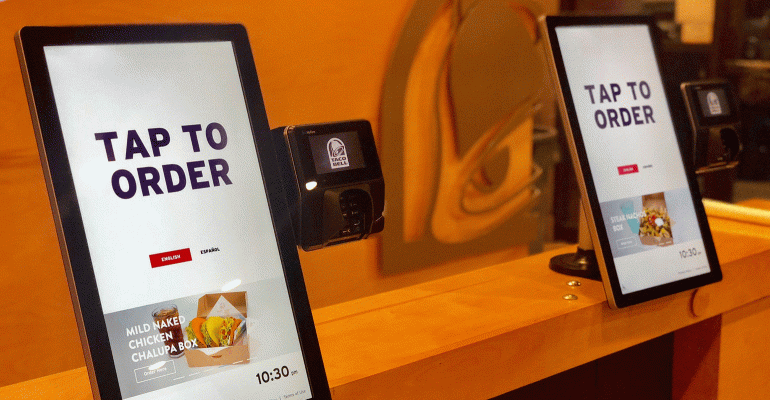Historically, service industries have operated under the mantra “the customer is always right.”
Today, the motto is in play more than ever in the restaurant industry. Whatever the customer wants, the customers gets — even if the request is technologically backwards or beyond a restaurant’s capabilities.
Take DoorDash. The third-party delivery operator still allows fax requests because some guests, albeit a small portion, prefer those types of orders, chief operations officer Christopher Payne said.

Still, that’s not where order and payment systems are headed in the restaurant industry. Point-of-sale systems are no longer restricted to processing cash or credit card payments at one terminal. They have become the central hub for processing multi-channel orders (even by fax), and a repository for tracking everything from consumer data to food inventory.
“What we have a is an evolution of point of sale. Now it’s platforms of sale,” said Jon Lawrence, senior director for, NCR Hospitality Solutions, a POS supplier.
Hacking the system to stay ahead
As a result of this evolution, legacy POS brands have been scrambling to catch up — creating cloud-based systems that integrate with a tangled web of restaurant software programs.
But some are not acting fast enough. That’s forcing concepts like Piada Italian Street Food to take matters into their own hands to meet consumer demands for speedy service.

Matt Eisenacher, chief concept officer for the 42-unit fast-casual chain, said the off-premise revolution has created multiple options for delivery. But it’s also created a “pinch point” at the POS level because the chain’s legacy POS provider must approve all integrations.
Tired of the bottleneck, Piada found a way to “hack” the system by creating their own “middle-ware” that talks to its back of house and front of house systems.
It was a do or die situation for them.
Before the hack, both online and walk-in orders flooded the kitchen at once. That caused Piada, based in Columbus, Ohio, to inflate their delivery times for mobile and online orders.

Now Piada’s MacGyvered POS can schedule online orders so they print at a scheduled time to ensure food is made on time and accurately. It’s also lowered the number of errors on carryout and delivery meals.
“We’ve cut make times from 40 minutes to 15 minutes,” Eisenacher said.
Some POS providers understand the urgency.
Legacy brand Heartland Commerce owns five brands which represent 19 percent of the U.S. restaurant POS market in all 50 states. Those systems can be found at Baskin-Robbins, Taco Bell, Jack in the Box, Panera Bread, and Panda Express.

But each system varied, and it was difficult to adapt each one to meet the industry’s demand for cloud-based systems, president Christopher Sebes said.
So, the company made the risky decision to rebrand and start over with a cloud-based system called Xenial.
“We set out to build [a new system] from scratch,” Sebes said.
The Xenial platform is agnostic, giving clients such as Taco Bell, Bojangles and Whataburger, the ability to use its mobile ordering and kiosk systems through iOS or Windows operating systems.

Design and democratization
In a world where everyone is paying for meals with phones and watches, hardware design is becoming just as important as programming.
Restaurants are not only demanding POS providers provide integration with multiple points of sale, but they’re also looking for chic designs. They want user-friendly systems for guests who are increasingly using self-serve POS systems in the form of kiosks and mobile devices.
That’s a stark contrast to clunky cash register terminals of the past.
“A traditional POS wasn’t built with the consumer in mind,” said Steve Fredette, co-founder and president and of Boston-based Toast, a fast-growing cloud-based restaurant software company whose clients include Jamba Juice and Pieology Pizzeria.

Traditional POS players are playing catch-up with the sleek systems provided by Toast and Square. The latter is considered one of the best-known modern-day POS innovators because the company’s famed “white” payment systems made it easier for startup retailers and restaurants to get off the ground.
The company’s card readers, for example, helped drive the food truck movement. The readers allowed these rookie restaurants on wheels to use mobile phones to process credit card payments, which is crucial in a cash-phobic society.
“Anyone with a smartphone could accept a payment. That first product was about the democratization of credit card payments,” said Jesse Dorogusker, head of hardware at Square.
A year or so later, with the debut of the iPad, Square gave consumers more control over payment. The white Square Stand, which swivels to face the consumer, is a plug and play POS system. The touchscreen technology allows consumers to review their order and add a tip — all with the touch of their finger.

It became a popular tool for emerging fast-casual chains. Early adopters were Blue Bottle, Salt and Straw and La Colombe.
Last year, the company introduced Square Register. Philz Coffee and Ben & Jerry’s are using the new platform to processes payments and track customer loyalty points without a punch card. It also features a separate terminal display for consumers.
As the POS evolution continues, expect more restaurants to gravitate to frictionless ordering systems because that’s what the consumer demands: speed and convenience, said Piada’s Eisenacher.
“Change is happening so hard, and so fast,” Eisenacher said. “If you wait, you can’t keep up with the guests’ desires.”
Contact Nancy Luna at [email protected]
Follow her on Twitter: @FastFoodMaven





